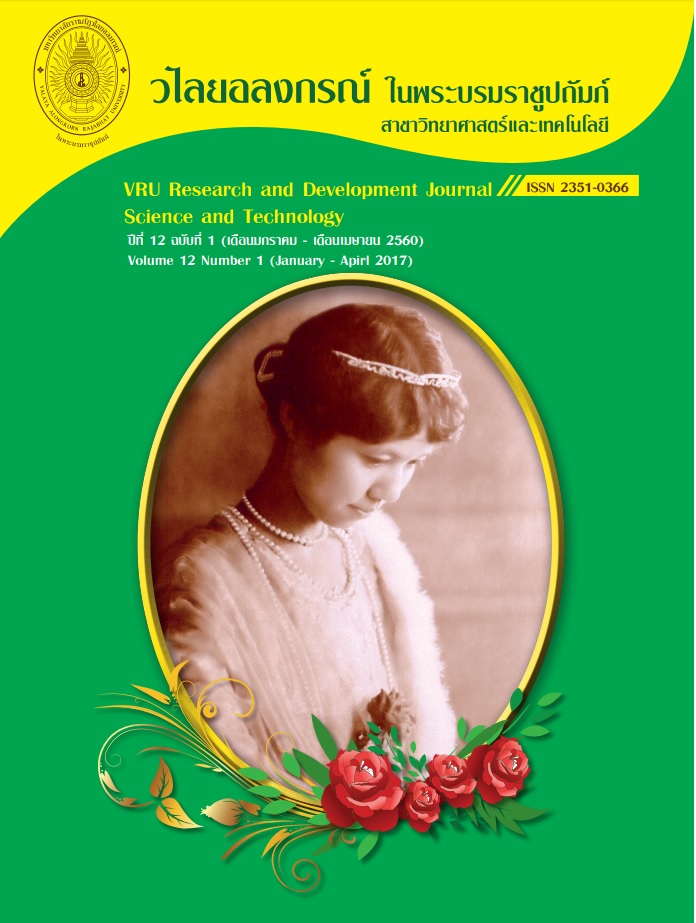การคัดแยกและศึกษาสมบัติบางประการของแอคติโนแบคทีเรียที่มีผลต่อการเสื่อมสภาพทางชีววิทยา ของโบราณสถานในอุทยานประวัติศาสตร์สุโขทัย
Main Article Content
Abstract
แอคติโนแบคทีเรีย เป็นแบคทีเรียแกรมบวก การเจริญมีลักษณะเป็นเส้นสาย ในจีโนมมีเบสกัวนีนกับไซโตซีนสูง งานวิจัยนี้มีวัตถุประสงค์เพื่อแยกและศึกษาสมบัติบางประการของแอคติโนแบคทีเรีย จากโบราณสถานในอุทยานประวัติศาสตร์สุโขทัย พบว่า จากการแยกเชื้อแอคติโนแบคทีเรีย โดยใช้อาหาร Starch Casein Agar สามารถแยกเชื้อได้ทั้งหมด 83 ไอโซเลต การศึกษาสัณฐานวิทยาภายใต้กล้องสเตอริโอ เมื่อเพาะเชื้อบนอาหารแข็ง Hickey & Tresner’s agar (HTA) พบว่า สีเส้นใยและสีสปอร์ของเชื้อมีทั้งสีขาว สีเทา สีดำ
สีน้ำตาลและสีเหลือง ขนาดโคโลนีมีทั้งขนาดใหญ่และเล็ก การหลั่งสารออกนอกเซลล์ที่ส่งผลต่อค่าพีเอชเมื่อเพาะเลี้ยงในอาหารเหลวสูตรกลูโคสที่ใช้โบรโมไทมอลบลูเป็นอินดิเคเตอร์ สามารถจัดกลุ่มเชื้อ 83 ไอโซเลต ได้
4 กลุ่ม คือ กลุ่มแรกผลิตสารที่ลดค่าพีเอชของอาหารเลี้ยงเชื้อแต่ไม่เปลี่ยนสีอินดิเคเตอร์ กลุ่มที่ 2 ผลิตสารที่เพิ่มค่าพีเอชของอาหารเลี้ยงเชื้อแต่ไม่เปลี่ยนที่อินดิเคเตอร์ กลุ่มที่ 3 ผลิตสารที่ลดค่าพีเอชของอาหารเลี้ยงเชื้อและเปลี่ยนสีอินดิเคเตอร์จากสีเขียวเป็นสีเหลือง และกลุ่มที่ 4 ผลิตสารที่เพิ่มค่าพีเอชของอาหารเลี้ยงเชื้อและเปลี่ยนสีอินดิเคเตอร์จากสีเขียวเป็นสีน้ำเงิน คิดเป็นร้อยละ 8.43, 3.61, 30.12 และ 57.83 ตามลำดับ รูปแบบการตอบสนองต่อสารปฏิชีวนะ 10 ชนิด ที่ใช้ทดสอบได้แก่ เจนตามัยซิน สเตรปโตมัยซิน เตตราซัยคริน โพลีมัยซิน บี กานามัยซิน ไรฟามพิซิน เบซิทราซิน คลอแรมเฟนิคอล แอมพิซิลินและอิริโทรมัยซิน ของเชื้อทั้ง 83 ไอโซเลต พบว่า มีหลากหลายรูปแบบ เมื่อสุ่มตัวอย่างเชื้อ 13 ไอโซเลต มาจำแนกโดยวิธีการหาลำดับนิวคลีโอไทด์ 16S rDNA พบว่า จำแนกได้เป็น Streptomyces, Norcardiopsis และ Actinomyces จำนวน 10, 2 และ 1 ไอโซเลต ตามลำดับ
Actinobacteria are bacteria with high GC content in the genome. The aim of experiment was to isolate and study some character of actinobacteria isolated from archeological site in Sukhothai historical park. A total of 83 isolates were obtained when used Starch Casein Agar for isolation. Morphological study under stereo microscope when culture on HTA agar found divest of colony and spore color such as white, gray, black, brown and yellow. The ability in secrete substance effect medium pH when used glucose broth medium with bromothymol blue as indicator can be divide 83 isolates into 4 groups; group one secrete substance with decrease pH but no change indicator’s color, group two secrete substance with increase pH but no change indicator’s color, group three secrete substance with decrease pH and change indicator’s to yellow color, and group four secrete substance with increase pH and change indicator’s to blue color as 8.43, 3.61, 30.12 and 57.83 % respectively. The ability to resist 10 types of antibiotics, namely rifampicin, erythromycin, polymixin-B, ampicillin, bacitracin, gentamycin, streptomycin, chloramphenicol, kanamycin and tetracycline found diverts character. The Random selected of 13 isolate for identified by sequencing 16S rDNA. The result found that 10, 2 and 1 isolate were closely related to genus Streptomyces, Norcardiopsis and Actinomyces respectively.
Downloads
Article Details
Copyright Notice
The copyright of research articles published in the VRU Research and Development Journal Science and Technology Journal belongs to the Research and Development Institute, Valaya Alongkorn Rajabhat University under the Royal Patronage. Reproduction of the content, in whole or in part, is prohibited without prior written permission from the university.
Responsibility
The content published in the VRU Research and Development Journal Science and Technology Journal is the sole responsibility of the author(s). The journal does not assume responsibility for errors arising from the printing process.
References
Abdulla, H., Morshedy, H. and Dewedar, A. (2008). Characterization of actinomycetes isolated from the indoor air of the church of Saint Katherine Monastery, Egypt. Aerobiologia. 24, 35-41.
Bartoli, F., Municchia, A. C., Futagami, Y., Kashiwadani, H. and Moon, K. H. (2014). Biological colonization patterns on the ruins of Angkor temples (Cambodia) in the biodeterioration vs bioprotection dabate. International Biodeterioration & Degradation. 96, 157-165.
Filomena, D. L., Agnese, L., Gabrielle, Z. and Clara, E. U. (2012). Chemoorganotrophic bacteria isplated from biodeteriorated surfaces in cave and catacombs. International Journal of Spelelogy. 41(2), 125-136.
Hueck, H. J., (Eds.). (1968). The Biodeterioration of Materials. An Appraisal, Biodeterioration of Materials. New York: Elsevier Publishing Co, Ltd.
Jeffrey, L. S. H. (2008). Isolation, Characterization and identification of actinomycetes from agriculture soil at Semongok, Sarawak. African Journal of Biotechnology. 35 (7), 3697-3702.
Johnson, H. M., (Eds.). (1965). Concrete Structure: Causes of Deterioration and Preventive Measure. New York: MacGrew-Hill Book Company.
Kumer R. and Kumer A. V., (Eds.). (1999). Biodeterioration of stone in tropical Environment: An overview. New York: The Getty Conservation institute.
Sravanthi, V., Babu, Z. F., Gregory, G. W., Elias, S., Seifollah, N., Ley, M. T. and Joshua, R. (2015). Isolation of a sulfur-oxidizing Streptomyces sp. From deterioration bridge structure and its role in concrete deterioration. International Biodeterioration & Degradation. 97, 128-134.
Walter, A. H. and Elphicks, J. J. (1968). Biodeterioration of Materials: Microbiological and Allied Aspect. Proceedings of the 1st International Symposium Southampton. (pp. 245-252). London: Elsevier Publishing Co, Ltd.


